| Method | Lithograph with tint stone |
| Artist | after David Roberts |
| Published | London, Published Augt. 1st. 1856, by Day & Son, Gate Street, Lincoln's Inn Fields |
| Dimensions | Image 142 x 210 mm, Sheet 198 x 288 mm |
| Notes |
Plate 188 from Volume 5 of the small format reprint of Roberts' The Holy Land, Syria, Idumea, Arabia, Egypt & Nubia. A general view of the Mortuary Temple of Ramesses III at Medinet Habu, on the West Bank of the Nile at Luxor, Egypt. The temple, very similar in size, scale, style, and location to the Mortuary Temple of Ramesses II, is famous for its well-preserved wall reliefs, particularly those commemorating the King's defeat of the enigmatic 'Sea Peoples,' variously identified as different sea-faring groups of Mediterranean origin, and often conjectured to have been Greeks, Lycians, and Phoenicians. In the Christian era, the central courtyard of the temple was converted into a Coptic church, with many of its wall reliefs removed or recarved to suit, though this church has since been removed. Roberts' view provides a view of the whole structure of the Mortuary Temple. At centre is the massive First Pylon, with the Migdol Tower to the left. On either side of the temple, Arab mud-brick houses have encroached on the precinct, particularly around the monumental enclosure wall. Two teams of camels use the road in front of the site, and the cliffs behind are dotted with the openings of rock-cut tombs. David Roberts RA (24th October 1796 – 25th November 1864) was a Scottish painter. He is especially known for a prolific series of detailed prints of Egypt and the Near East produced during the 1840s from sketches made during long tours of the region (1838-1840). This work, and his large oil paintings of similar subjects, made him a prominent Orientalist painter. He was elected as a Royal Academician in 1841. The firm of Day & Haghe was one of the most prominent lithographic companies of the nineteenth-century. They were also amongst the foremost pioneers in the evolution of chromolithography. The firm was established in 1823 by William Day, but did not trade under the moniker of Day & Haghe until the arrival of Louis Haghe in 1831. In 1838, Day & Haghe were appointed as Lithographers to the Queen. However, and perhaps owing to the fact that there was never a formal partnership between the two, Haghe left the firm in the 1850's to devote himself to watercolour painting. The firm continued as Day & Son under the guidance of William Day the younger (1823 - 1906) but, as a result of a scandal involving Lajos Kossuth, was forced into liquidation in 1867. Vincent Brookes bought the company in the same year, and would produce the caricatures for Gibson Bowles' Vanity Fair magazine, as well as the illustrations for Cassells's Poultry Book, amongst other commissions. Condition: Light foxing to margins, not affecting image. |
| Framing | unmounted |
| Price | £30.00 |
| Stock ID | 39179 |

